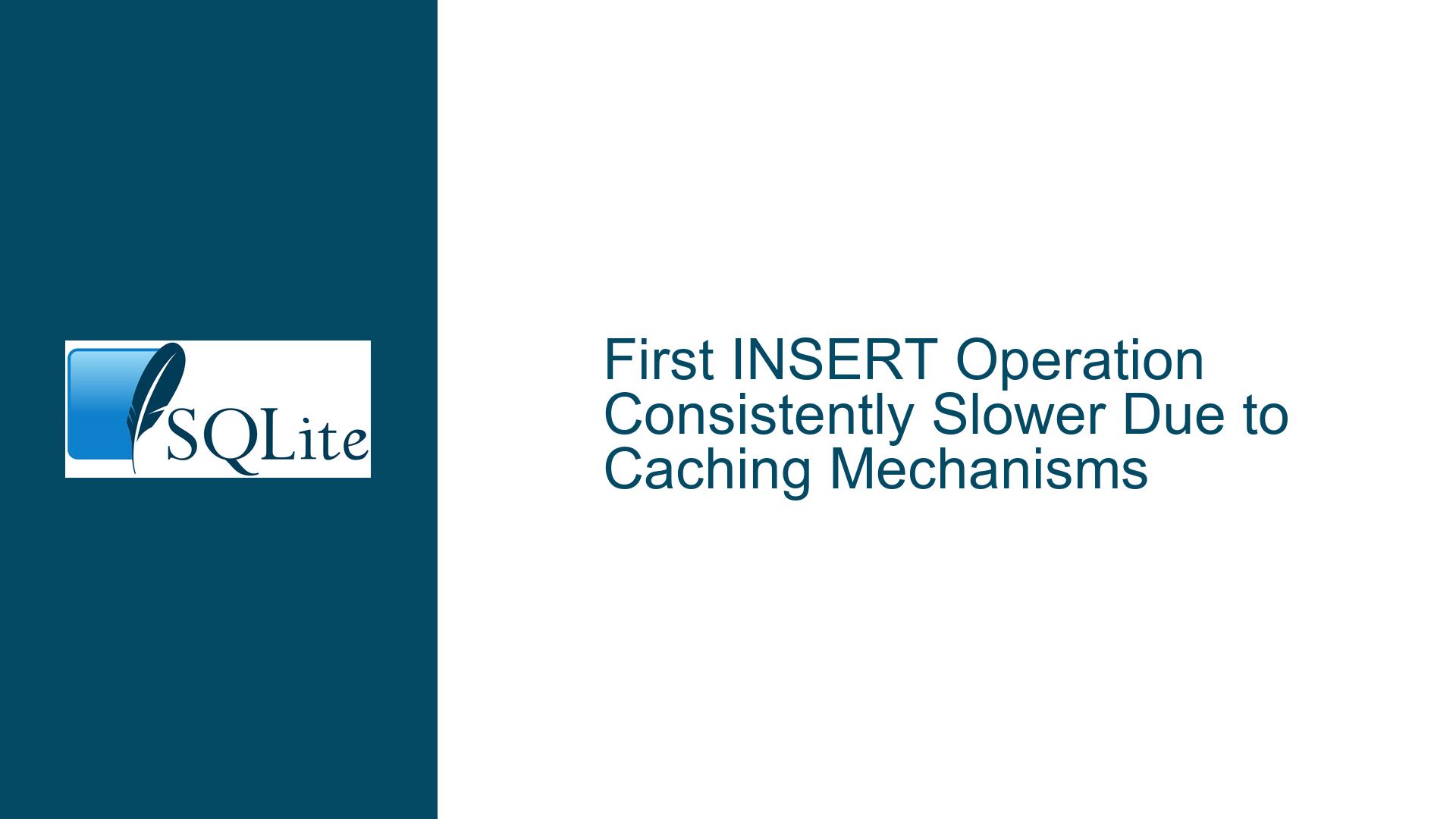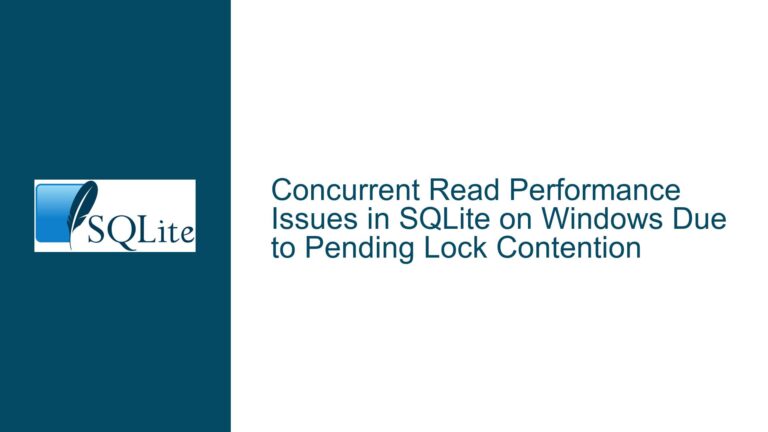First INSERT Operation Consistently Slower Due to Caching Mechanisms
Understanding the Impact of Caching on Initial Data Insertion Performance
The core issue revolves around the observation that the first INSERT operation in a sequence of bulk data imports consistently takes significantly longer than subsequent operations. This behavior is observed even when inserting similar volumes of data into structurally identical tables. For example, inserting 10,000 rows into the first target table (PL_ProjType_Search) might take 9.77 seconds, while subsequent inserts into PL_ProjName_Search, PL_Contact_Search, and PL_ClarityPM_Search complete in under 0.25 seconds each. The pattern persists even when the order of operations is changed, confirming that the slowdown is tied to the first operation, not the specific table or query.
This discrepancy arises from the interplay between SQLite’s internal mechanisms, operating system (OS) caching strategies, and hardware limitations. The problem is most pronounced when working with large source tables (e.g., Project_List with millions of rows) and target tables that use default rowid-based storage. The delay occurs because the first INSERT must read the source data from slower persistent storage (e.g., disk or SSD) into faster memory caches, while subsequent operations benefit from cached data. Resetting the environment (e.g., restarting the application or flushing caches) reintroduces the delay, confirming that caching is the primary factor.
Root Causes: Storage Access Patterns and SQLite-Specific Overheads
1. Cold Cache Penalty During Initial Data Access
When a SQLite database operation accesses a table for the first time, the required pages (blocks of data) must be fetched from storage into memory. This process, known as a "cold read," incurs significant latency compared to accessing data already resident in RAM. For large tables like Project_List, this involves reading hundreds or thousands of pages from disk. The OS and SQLite’s page cache work together to retain these pages in memory, dramatically speeding up subsequent accesses. However, the first INSERT operation bears the full cost of populating these caches.
2. Rowid Management in Standard Tables
By default, SQLite uses a rowid (or an implicit INTEGER PRIMARY KEY) to organize table data. This structure introduces overhead during INSERT operations, as the database must maintain a B-tree for the rowid and secondary indexes. While this design offers flexibility, it can lead to fragmentation and suboptimal insertion performance, especially when inserting unordered data. The WITHOUT ROWID clause eliminates this overhead by using a clustered index based on the primary key, which aligns insertion order with the primary key’s structure. However, improper use of WITHOUT ROWID (e.g., unordered inserts) can negate these benefits.
3. Data Locality and Insertion Order
The physical arrangement of data on disk affects read performance. If the source table (Project_List) is scanned in an order that mismatches the target table’s primary key, SQLite may incur additional I/O overhead to reorganize data. For example, inserting rows sorted by ProjID, Project_Type into a WITHOUT ROWID table with a matching primary key minimizes page splits and disk seeks. Conversely, inserting unordered data forces the database to rearrange pages during the INSERT, increasing latency.
Resolving the Slow Initial INSERT: Strategies and Technical Adjustments
1. Validate Caching Behavior with Preloading
To confirm that caching is the primary factor, manually load the source table into memory before executing the first INSERT. This can be done using a dummy query that forces SQLite to read all relevant pages:
SELECT COUNT(*) FROM Project_List; -- Forces full table scan
After running this query, immediately execute the INSERT operations. If the first INSERT now completes quickly, caching is confirmed as the root cause. Note that this approach does not reduce total execution time but redistributes the latency to the preload step.
2. Adopt WITHOUT ROWID for Primary Key-Aligned Tables
Convert the target tables to use WITHOUT ROWID storage, ensuring the primary key matches the insertion order. For example:
CREATE TABLE PL_ProjType_Search (
ProjID,
Project_Type,
InsertDate,
PRIMARY KEY (ProjID, Project_Type)
) WITHOUT ROWID;
This eliminates the rowid B-tree and clusters data by the primary key, reducing insertion overhead. However, the source data must be sorted to match the primary key order:
INSERT OR IGNORE INTO PL_ProjType_Search
SELECT ProjID, Project_Type, InsertDate
FROM Project_List
ORDER BY ProjID, Project_Type;
Failure to sort the source data will result in page fragmentation, negating the benefits of WITHOUT ROWID.
3. Optimize SQLite’s Page Cache and Schema Design
Increase the SQLite page cache size to retain more data in memory, reducing reliance on OS caches. Use the PRAGMA command to adjust cache parameters:
PRAGMA cache_size = -20000; -- Allocate 20,000 pages (~32MB for 16KB pages)
Additionally, ensure the database page size aligns with the OS’s I/O block size (typically 4KB). For large datasets, a 16KB page size often balances performance and fragmentation:
PRAGMA page_size = 16384; -- Set before creating tables
Combine these settings with WITHOUT ROWID tables and sorted inserts for optimal results.
4. Leverage Batch Transactions and Write-Ahead Logging
Wrap all INSERT operations in a single transaction to minimize disk I/O and journaling overhead:
BEGIN;
INSERT OR IGNORE INTO PL_ProjType_Search ... ;
INSERT OR IGNORE INTO PL_ProjName_Search ... ;
-- Additional inserts
COMMIT;
Enable Write-Ahead Logging (WAL) for concurrent read/write access and reduced lock contention:
PRAGMA journal_mode = WAL;
5. Hardware and OS-Level Adjustments
If the dataset exceeds available RAM, consider upgrading hardware or using faster storage (NVMe SSDs). On Linux, adjust the OS’s vm.swappiness parameter to prioritize keeping SQLite’s pages in memory:
sysctl vm.swappiness=10
On Windows, ensure the SQLite process has sufficient working memory via the System Configuration utility (msconfig).
By systematically addressing caching behavior, storage engine configuration, and data locality, the performance discrepancy between the first and subsequent INSERT operations can be minimized. Implementing WITHOUT ROWID tables with sorted inserts and optimizing cache settings are particularly impactful for large-scale data workflows.






